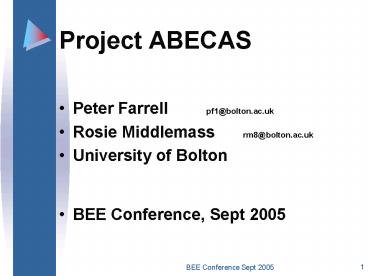Project ABECAS - PowerPoint PPT Presentation
1 / 22
Title: Project ABECAS
1
Project ABECAS
- Peter Farrell pf1_at_bolton.ac.uk
- Rosie Middlemass rm8_at_bolton.ac.uk
- University of Bolton
- BEE Conference, Sept 2005
2
Complying with DDA and SENDA bringing disabled
people into the construction professions
3
Introduction
- Contents
- 1. DDA / SENDA
- 2. ABECAS barriers
- 3. Anticipating reasonable adjustments
- 4. Type 3 barriers
- 5. General discussion
- 6. Other work DART
4
1. DDA / SENDA
- Must not discriminate
- Make reasonable adjustments
- Employment the job (not the infrastructure ?)
- Education the educational experience (not the
infrastructure)
5
2. ABECAS accessible built environment careers
for all students
- Supported by National Disability Team
www.natdisteam.ac.uk - Aim to remove artificial barriers that prevent
students with visual, hearing and mobility
impairments from undertaking professional careers
in the construction industry - Other disabilities dyslexia dyscalculia mental
health diabetes autism aspergers syndrome
epilepsy - Making adjustments
6
2. ABECAS - outcomes
- Tangible guidance for 4 stakeholder groups
STUDENTS
PROF BODIES
HEIs
EMPLOYERS
- Desirable increase numbers of students with
visual, hearing and mobility impairments
undertaking built environment degree subjects and
becoming chartered
7
2. ABECAS levers for change
- SENDA
- Validation systems
- Accreditation systems
8
2. ABECAS - barriers in curricula
- Learning outcomes, range indicators
- Teaching and learning strategies
- Assessment
- Assessment criteria
9
2. ABECAS - barriers in curricula
- Generic lectures, presentations, exams
- Bespoke barriers - laboratories, fieldwork,
groupwork, practical, placements, drawings,
industry software - Individual students individual tutors /
lecturers
10
2. ABECAS Barriers - definitions
- Type 1 unwittingly semantics learning
outcome carry out survey change to
understand how to carry out a survey - Type 2 make adjustments learning outcome
understand how to carry out a survey
assessment carry out a survey adjustment
direct third person to carry out survey
11
2. ABECAS Barriers - definitions
- Type 3 cannot be removed
- to maintain academic standards, or if they are
material to circumstances and substantial
(SWANDS, 2002 103).
12
3. Anticipating reasonable adjustments
- Teaching and learning surveying visual
impairment electronic notes in advance, written
description of drawings and sketches, DVDs with
subtitles, models of survey areas, touchy feely
approach to explaining instruments, one-to-one
tutorials and extra technician support (cost no
defence). Healthy budget for equipment.
13
3. Anticipating reasonable adjustments
- Teaching and learning structures hearing
impairment laboratory experiment written notes
of experiment, DSA funding for interpreter,
observation stations, yellow paint lines on
floors, vibrating alarm, budget for flashing
lights on equipment - Assessment use criteria for marking written work
of deaf students
14
3. Anticipating reasonable adjustments
- Teaching and learning technology mobility
impairment site visits eight storey building,
concrete to roof, CCS site, transport to site,
disabled car parking space, fix grab rails to
ladies loo, notice for site workers, pre-tour by
site manager, passenger hoist, digital
camera/video, emergencies, mobile phones etc
15
4. Type 3 barriers for discussion
- A chartered construction professional loses his
eyesight through diabetes. He can no longer meet
the competencies normally expected of his
profession should he be able to continue his
professional institute membership, continue to
practice and continue to advise clients ?
16
4. Type 3 barriers for discussion
- A construction graduate loses her eyesight over a
short period after graduation through diabetes.
She can no longer meet the competencies of her
Institutes PDP should she be permitted to
become chartered ?
17
4. Type 3 barriers for discussion
- Examinations a student has difficulty
concentrating over long periods and asks for
examinations to be adjusted to coursework - University perspective
- Employer perspective
18
4. Type 3 barriers for discussion
- A professional institute competence stipulates
that candidates should - give an oral presentation deaf candidate
- measure quantities blind candidate
- survey the roof to a structure mobility
impaired candidate - calculate a beam size dyscalculia candidate
- have one year site experience epileptic
candidate - Should these competencies be adjusted? Yes or no
if no, why - if yes, how
19
4. Type 3 barriers for discussion
- Any other competencies that could be justified as
being type 3 in the courts ? - Do construction professionals have to be
front-line i.e. must a chartered surveyor be
able to survey ?
20
5. Generally for discussion
- Is there a difference between HEIs and
professional institutes / employers ? Guardians
of different things ? - HEI perspective disabled students to
participate and achieve to the maximum of their
potential - Professional institute / employer perspective
members / employees must be competent to do
21
5. Generally for discussion
- How do we demonstrate to third parties that we
have fulfilled our anticipatory responsibilities
? - Resource implications to comply with DDA / SENDA
money and time ? - How well are we doing ?
22
6. Other work
- DART (2005) Disabilities Academic Resource Tool
Project. Engineering Education Centre,
Loughborough University. http//dart.lboro.ac.uk - Feedback please































